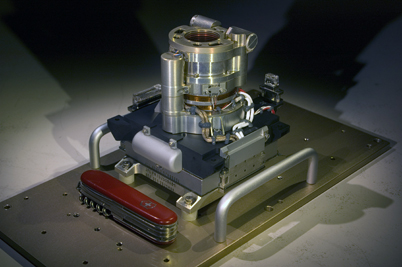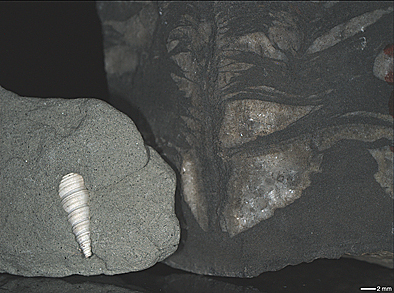MALIN SPACE SCIENCE SYSTEMS, INC.
SAN DIEGO, CA 92191-0148
TELEPHONE: (858) 552-2650, EXT. 500
http://www.msss.com/
Contact: Michael Ravine, ravine@msss.com
FOR IMMEDIATE RELEASE: 24 October 2008
MSSS DELIVERS “HAND LENS” SCIENCE CAMERA TO JPL FOR 2009 MARS ROVER MISSION
Malin Space Science Systems, Inc. (MSSS), has delivered the second of four science cameras it is developing for the NASA/Jet Propulsion Laboratory 2009 Mars Science Laboratory (MSL) rover mission. This camera, the Mars Hand Lens Imager (MAHLI—see Figure 1) is designed to provide close up color images of rocks and soils on the martian surface. The camera will be mounted on the end of the rover’s robotic arm, and positioned as close as an inch from its targets, allowing it to acquire in situ images of rock textures at scales much finer than ever before.
MAHLI was transported from the MSSS facility in San Diego to JPL last week for an extremely sensitive contamination measurement (Figure 2). That test was completed satisfactorily on 15 October, and instrument functionality was verified in testing the following day. The instrument now awaits integration with the MSL rover.
The MAHLI instrument can focus on targets at working distances (the distance between the front of the camera lens to the target) of 22.5 millimeters (0.9 inch) to infinity. At close range, MAHLI’s color images will have a scale of about 15 micrometers (about 0.0006 inch) per pixel and cover an area of about 18 by 24 mm (0.7 by 0.9 inch). Figure 3 shows an example of a MAHLI image acquired at a scale of 34 microns (0.001 inch) per pixel. Typical MAHLI operations will involve imaging geologic materials at multiple, nested scales at different working distances.
“We will use MAHLI like a terrestrial field geologist uses a hand lens to resolve the size and shape of the grains that make up the rocks and wind-blown regolith on Mars,” said Kenneth Edgett, who leads the MAHLI effort. “Resolving those grains, if in a sedimentary rock, will tell us a lot about how they were formed and how they were transported—whether by wind or water—and thus what Mars was like at the time they were deposited.”
MAHLI focus is controlled by a precision mechanism developed by Alliance Spacesystems (www.alliancespacesystems.com). This mechanism uses a stepper motor to position the internal focus group by means of a cam. It also incorporates a linkage to drive a cover that protects the MAHLI lens from martian dust. The dust cover is clear, and the mechanism allows focus to be adjusted independent of cover position, so MAHLI can acquire images with the cover open or closed.
MSSS is also providing three other cameras for the MSL mission: the two Mast Cameras (Mastcams) and the Mars Descent Imager (MARDI). The two Mastcams will provide moderate resolution and high-resolution telephoto still and motion imaging capability in color, and will be the science imaging “workhorse” for the MSL rover. The MARDI, delivered to JPL in July, will obtain color images of the martian surface during the descent of the MSL spacecraft to the surface.
The Mastcam, MAHLI, and MARDI investigations were selected in 2004 by NASA’s Science Mission Directorate in an open competition. The instruments share a common electronics design and are being developed by Malin Space Science Systems, Inc., of San Diego, CA, under a single $18.9 million contract with Caltech’s NASA-funded Jet Propulsion Laboratory in Pasadena, CA.
MSSS is also currently operating two cameras onboard NASA’s Mars Reconnaissance Orbiter (MRO), the Mars Color Imager (MARCI) and the Context Camera (CTX). MARCI provides a daily global weather map of Mars in five colors and two ultraviolet bands. CTX images Mars at 6 m per pixel resolution, and has already mapped more than 37% of the planet at that scale. Pictures from these cameras and other activities of the company are described at www.msss.com.
« Back to News Index















 Copyright 2023 All rights reserved.
Copyright 2023 All rights reserved.